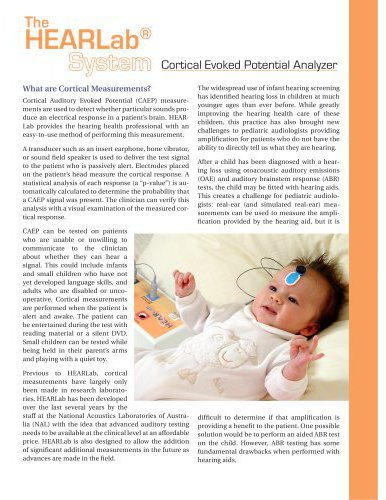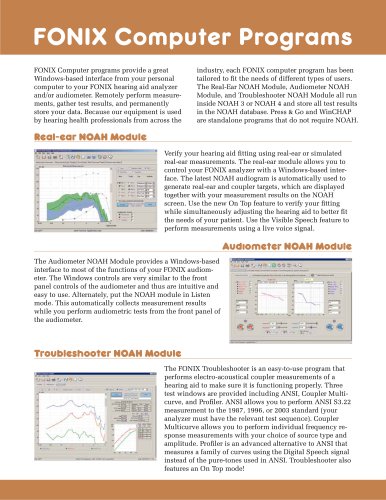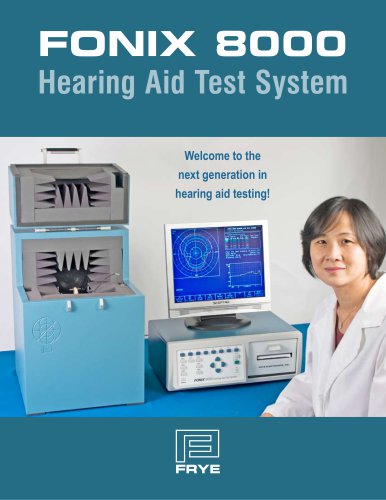
Catalog excerpts

® Cortical Evoked Potential Analyzer What are Cortical Measurements? Cortical Auditory Evoked Potential (CAEP) measurements are used to detect whether particular sounds produce an electrical response in a patient’s brain. HEARLab provides the hearing health professional with an easy-to-use method of performing this measurement. A transducer such as an insert earphone, bone vibrator, or sound field speaker is used to deliver the test signal to the patient who is passively alert. Electrodes placed on the patient’s head measure the cortical response. A statistical analysis of each response (a “p-value”) is automatically calculated to determine the probability that a CAEP signal was present. The clinician can verify this analysis with a visual examination of the measured cortical response. The widespread use of infant hearing screening has identified hearing loss in children at much younger ages than ever before. While greatly improving the hearing health care of these children, this practice has also brought new challenges to pediatric audiologists providing amplification for patients who do not have the ability to directly tell us what they are hearing. After a child has been diagnosed with a hearing loss using otoacoustic auditory emissions (OAE) and auditory brainstem response (ABR) tests, the child may be fitted with hearing aids. This creates a challenge for pediatric audiologists: real-ear (and simulated real-ear) measurements can be used to measure the amplification provided by the hearing aid, but it is CAEP can be tested on patients who are unable or unwilling to communicate to the clinician about whether they can hear a signal. This could include infants and small children who have not yet developed language skills, and adults who are disabled or uncooperative. Cortical measurements are performed when the patient is alert and awake. The patient can be entertained during the test with reading material or a silent DVD. Small children can be tested while being held in their parent’s arms and playing with a quiet toy. Previous to HEARLab, cortical measurements have largely only been made in research laboratories. HEARLab has been developed over the last several years by the staff at the National Acoustics Laboratories of Australia (NAL) with the idea that advanced auditory testing needs to be available at the clinical level at an affordable price. HEARLab is also designed to allow the addition of significant additional measurements in the future as advances are made in the field. difficult to determine if that amplification is providing a benefit to the patient. One possible solution would be to perform an aided ABR test on the child. However, ABR testing has some fundamental drawbacks when performed with hearing aids.
Open the catalog to page 1
Most digital hearing aids have a digital processing delay of at least 3 milliseconds (ms), and some digital hearing aids have a delay of more than 10 ms. Since the neural signal in the ABR test is received a few milliseconds after the reception of the auditory test stimulus, the delay of the digital hearing aid can interfere with the certainty of the ABR result. The ABR test also uses a short impulse stimulus type that is not speech-like and may not be processed properly with a hearing aid. In fact, the energy of the ABR impulse signal can actually momentarily saturate the hearing aid...
Open the catalog to page 2All Frye Electronics catalogs and technical brochures
-
FONIX COLT
4 Pages
-
FONIX Computer Programs
2 Pages
-
FONIX FP35
2 Pages
-
FONIX 8000
4 Pages
-
HEARLAB
1 Pages






